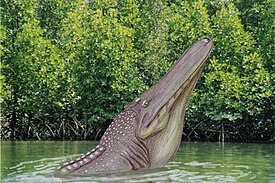Stomatosuchus [1] ( lat. Stomatosuchus , from other Greek στοματο- + σοῦχος , literally a crocodile with a large mouth) is a genus of giant crocodilomorphs from the family Stomatosuchidae that lived during the Cretaceous period (Upper Cenomanian , 99.6–93, 5 million years ago). It includes a single type species - Stomatosuchus inermis [2] . It is described by E. Shtromer in 1925 on the basis of a skull discovered in 1912 in the oasis of Baharia ( Egypt ). The only specimen was destroyed during the bombing of Munich in 1944.
| † Dentist |

Reconstruction |
| Scientific classification |
|---|
| No rank : | Bilateral symmetrical |
| Infraclass : | Archosauromorphs |
| No rank : | Archosauriformes |
| Squadron : | Crocodilomorphs |
|
| International scientific name |
|---|
Stomatosuchus Stromer , 1925 |
| Single view |
|---|
| † Stomatosuchus inermis Stromer, 1925 |
Geochronology99.6-93.5 Ma | million years | Period | Era | Aeon |
|---|
| 2,588 | Even | | | Ka | F
but
n
e
R
about
s
about
th | | 23.03 | Neogene | | 66.0 | Paleogen | | 145.5 | a piece of chalk | M
e
s
about
s
about
th | | 199.6 | Yura | | 251 | Triassic | | 299 | Permian | P
but
l
e
about
s
about
th | | 359.2 | Carbon | | 416 | Devonian | | 443.7 | Silur | | 488.3 | Ordovician | | 542 | Cambrian | | 4570 | Precambrian |
◄ Nowadays◄ Cretaceous-Paleogene extinction◄ Triassic extinction◄ Mass Permian Extinction◄ Devonian extinction◄ Ordovician-Silurian extinction◄ Cambrian explosion |
|---|
|
Content
It features unique anatomical features. The skull is about 2 meters long, very long, flat and wide (resembles an ironing board in shape). Dental alveoli are only in the upper jaw, numerous (up to 30 pairs) and very small (1.5 cm in diameter), the teeth themselves were not preserved. Teeth could be in the lower jaw, but alveoli were not found (destroyed?). The upper temporal windows are reduced to small openings, the lower ones are also medium-sized (indicating weak muscles). The eye sockets are brought together, taken up. The lower jaw is extremely thin, in the back of it there are developed high, downward-directed ridges. Apparently, the crests could support the throat sac, like that of a pelican or minke whales . The postcranial skeleton is not known, Shtromer pointed to a reduction in the shell (despite this, the dentosucha is usually depicted covered with osteoderms common to crocodiles). Given the length of the skull, the total length could be up to 10 meters or more, although the head was probably very large in relation to the body.
Dentosuch lifestyle is obscure. It is possible that he ate small aquatic animals (or even algae), which he filtered through small teeth. A similar food specialization arose in the Miocene in net codans ( Mourasuchus ), which had a similar skull structure.
The stomatosuchus inhabited the mangrove swamps of North Africa at the same time as the spinosaurs and the Carcharodontosaurus . Spinosaurus, perhaps, could attack these crocodiles, deprived of a powerful shell and therefore very vulnerable.
In 2009, Paul Sereno described the lower jaw of two crocodile species in the genus Laganosuchus from the Cenomanian of Niger and Morocco . These crocodiles (the length of the lower jaw is 87 cm) are the closest known relatives of the dentosuchus from the family Stomatosuchidae . Unlike the dentosuchus, the smaller Laganosuchus had mandibular teeth. Sereno suggested that such crocodiles hunted small water prey from an ambush.
